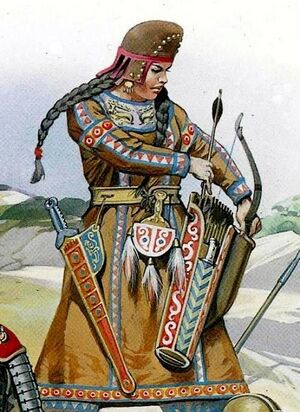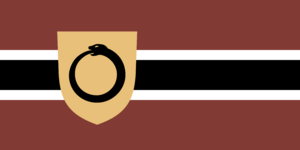Easwegian history
This article contains information pertaining to a fictional micronation, micronationalist or other fictional element of micronational society or culture. |
The Easwegians are a polyethnic nation who primarily inhabit Easway, located in the Barents Region. Beginning as disunited clans, the Easwegian nation began to form when Ezaari, Norwegians and Pomors pledged allegiance to the Easwegian Commonwealth; a feudal republic and former outpost of the Novgorod Republic; in 1478. This Commonwealth is said to have existed until subjugation by Sweden-Norway in 1821. During a period of scattering between 1821 and 2017, Easwegians had no independent state and largely lived as diaspora. A movement founded in 2015 led Easway to independence on 19 December 2017.
As a cultural identity, the Easwegians may trace their lineage back through the legends connected to the ethnic Ezaari's nomadic past, whereby they originated in 1500 BC as a clan of the Karasuk culture in the Altai mountains, known as the Khayezaareix, the Thousand Clans. The Khayezaareix are recorded to have travelled throughout Central Asia and had interactions with various Indic, Iranic and Turkic tribes, which has influenced Ezaari Easwegian culture heavily. In the 7th century, the Khayezaareix are said to have united with the Alanic tribes of the east and the Turkic Ashina tribe to form a polity centred around the Pontic-Caspian Steppe known as the Khazar Khaganate.

Altai Beginnings and Ethnogenesis
The Khayezaareix originated as an unnamed tribe of the Karasuk culture, within the Altai Mountains, a crossroad of different Turkic, Sino and Siberian polities, specifically linked to the Yeniseians, whereby the Ezaari Ezerryen language stems from. It is unknown how much interaction these tribes had with the Indo-European Andronovo culture, which the Karasuk culture replaced.
From on or around 1000 BC, several tribes of the Karasuk began moving south of the Altai mountains towards the Tarim Basin (today part of the homeland of the Uyghurs). Here, they interacted with the Iranic Saka culture. In roughly 800 BC, these convergences of culture formed a group known as the Khayezaareix (or Ghayezaareix), an Indo-European name which means Thousand Clans. This is said to be the earliest instance of an Easwegian identity forming.
Within the next century, the tribe likely had conflict with the Tocharians and the Khayezaareix travelled through the Karakorum pass of the Himalayas with at least one other tribe, possibly the Burusho, and reached Kashmir.

Scythians

Crimean Khayezaareix
The Crimean Khayezaareix are likely closely related to, or identical to the Agathyrsin and Akatziri, as referenced in literature.
Khazar Khaganate (650-959)
Prelude - The Alano-Khezaari and the Ashina
The fall of Crimea to the expanding Gothic Kingdom in the 4th century marked a turning point for the Khayezaareix. Its clans had largely existed within the peninsula since 3rd century BC as a decentralised but settled tribe, which was a marked turn from their long journey from the Altai mountains millenia before. The brutality of the Goths had not gone unnoticed by neighbouring groups and, as the Khayezaareix fled east towards the steppe, they allied with the Iranic Alans, forming a new identity known as the Alano-Khezaari, also known as the Arsiyah.[1] This newly formed tribe formed a military culture which subsequently marched east towards inner Scythia.

The Alano-Khezaari reached Mount Imeon, an area the Khayezaareix had inhabited roughly one thousand years before. The entire region during this period was controlled by the Göktürk Khaganate, which was itself embroiled in a multi-pronged civil war. The Alano-Khezaari pledged allegiance to the ruling Ashina tribe and headed with an army of 30,000 men and tribes including including Šarağurs, Oğurs, Onoğurs, Bulğars, and other steppe nomads and peoples from Sogdiana, reaching the river Don during the reign of Byzantine Emperor Mauritius (582-602).
Formation
The Khazar Khaganate formed as the largest polity from the breakup of the Western Turkic Empire in 650. It was not itself a homogoneous state, but a large union of ethnically distinct nomadic tribes, including the Alano-Thousandaires (Hezaareix), in which it was named after. In this context, Khazar was of ultimately Iranic roots for thousand or multitude, and came to take the meaning of Great Khaganate.
The Alano-Khezaari, the Arsiyah, formed the military elite of the Khazars, and held great political power. The Khaganate adopted a dual-kingship system, with the Arsiyah often promised the title of bek.
The Khazars under the advice of the Arsiyah, then natively beginning to go by Ezaari, led a massive army which invaded Crimea, ending the Gothic Kingdom on the Peninsula and establishing it as a Khazar tudun.
Ras Tarkhan is noted of being an Ezaari. He was natively known as Ziaaghan Ezaari.
Heading North and the Novgorod Republic
Easwegian Commonwealth (1478-1821)

With Novgorod's fall to the Muscovy state in 1478, the new regime wished to take all high-ranking members of Novgorod society to Moscow for punishment. Fearing execution for the leader of the resistance, the Easwegian Guard guaranteed the safety of Martha the Mayoress and moved north towards the Barents Sea and the Iron Commonwealth. No longer tied as an outpost colony of the recently capitulated Novgorod Republic, the Ezaari, Pomors and Norwegian sailors pledged allegiance to Martha and the newly formed Easwegian Commonwealth.

Scattered Years (1821-1925)
Spitsbergen Treaty and Developments (1925-2015)
Restoration and Independence of Easway (2015-present)
Easwegian National Movement
The Easwegian National Movement, with the stated aim of an independent Easwegian state, is accredited to have began on 20 October 2015 when Emilierzei, adopting the name of Emizerri, established, alongside Dr. Mooshroom, and Oelaanni Creizoun, a semi-underground nationalist organisation known as the Cyber Council Easwegian Alliance (CCEA). The English term 'Easwegian' was coined by Emizerri, who had based it on an old term Icelandic Vikings had used to refer to the Ezaari in the 12th century, that is 'Austmenn.' Previously, Easwegians had referred to themselves in English by the Ezerryen term 'Zerri' (rich people).
The CCEA had the explicit aim of restoring Easway to its Commonwealth-era territory, including Biarmia and the Svalbard Isles, although centred its campaign on Bear Island due to the entirety of Svalbard being more easily accessible being visa free. For this reason, the CCEA directed its criticism towards the Norwegian Government, then led by the Conservative Party, and their actions in Vardø in using the island for spy purposes against Russia. The Easwegian national movement accused the Norwegian Government of 'militarising the arctic' and 'endangering regional stability.' Furthermore, it accused their administration of poisoning ancient Easwegian land with chemicals such as PCPs. The CCEA's campaign was quite effective in recruiting the Easwegian diaspora to the cause, most notably Aleksou Desourrë, who was fundamental in preparing the movement towards the next stage in achieving initial independence.
Easwegian Rebirth
Prelude

The CCEA put out a strongly worded statement in late October 2017 towards the Norwegian Conservative foreign minister Børge Brende, who had just been appointed as president of the World Economic Forum. Within it, it accused Brende of corruption, acting as a dangerous diplomat, and being purely self-interested. It also alleged a lack of functioning democracy under Oslo and hinted at a coming push towards Easwegian independence.
References
- ↑ Armament and military affairs of the Khazar Khaganate (Russian) http://archaeology.kiev.ua/journal/020300/komar_sukhobokov.htm